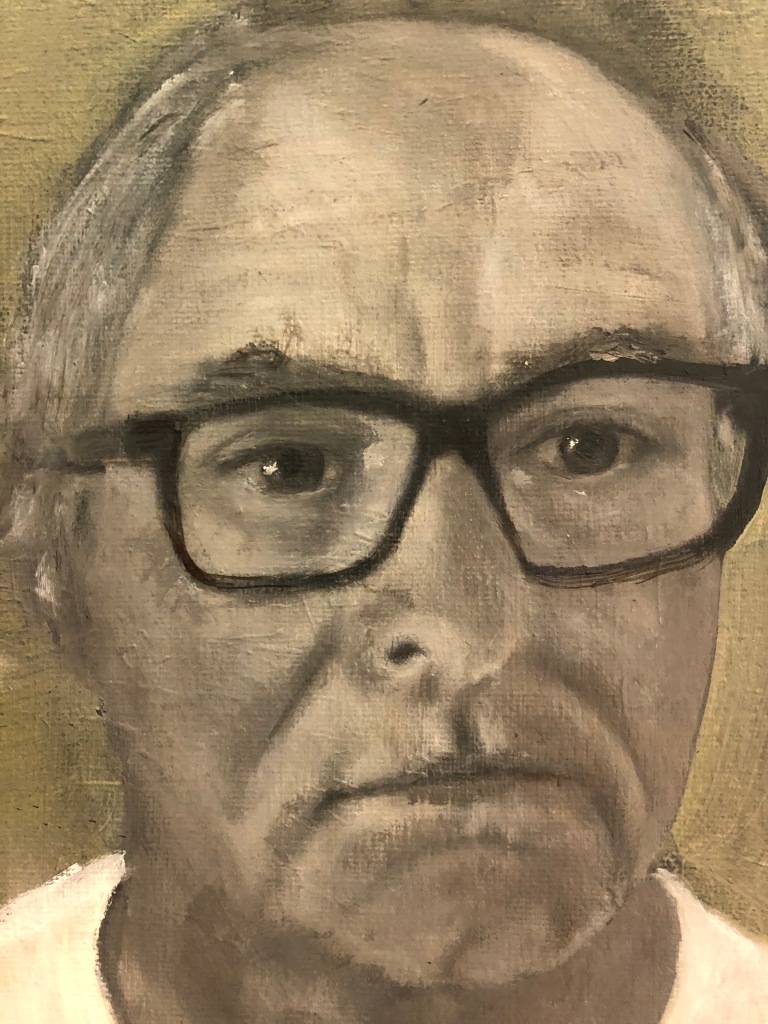During the last few weeks I started a portrait of my husband. I used a photo taken a while ago as my reference. I did not feel confident to do a colour painting and decided to work on a grisaille. I find that I have to concentrate on this method in order to lay stronger foundations of my own painting techniques. I have not painted in more than two years, before starting with POP, and feel my confidence is still lacking.
I have always loved classical painting and Bougereau and Velazquez are of my favourite masters in figurative work.
I started with a drawing onto the canvas for this assignment. I also started another work, just with paint where I wanted to work loose- and was not happy with this attempt. I will show the work below. I know I was in a hurry to add it to my assignment, worked under pressure, but even the shape of the skull was not good, from the start.
For my classical style grisaile painting I worked with Raw Umber, Ivory Black and Titanium white. (Velazquez apparently worked with Ivory Black, to which he added a little Burnt Sienna, to give him a warm black; for a more Blue-Black, he added a little cobalt blue. This would give him a cool black.) Harold Speed ( Oil Painting Techniques and Materials), in the chapter on Painting from Life, contemplates that Rembrand could have worked on his portraits with “stiff untidy brushes that scratched the paint on very crisply, and left strong ridges everywhere” many times. He used thin, solid colour painted of a transparent glaze to get a pearly quality and amazing half-tones. It is the play of solid and thin paint that attracts my attention.
My painting method was slow, from the drawing to the end. I tried to ensure that the viewers gaze with be focussed on my model’s gaze. I took these photos of Tienie while he was working on his love for carpentry, in his workshop at home in South Africa, late in 2017. I used a video tutorial of Will Kemp, which I bought back in 2016 to guide me through the process of painting. I worked with small filbert brushes, and lots of dry brushing. My medium was Linseed oil and OMS (discovered Sansodor here in Dubai). Here the main thing was never to overload the brush with paint.
Working over time on this painting, helped me to not get stuck in small details. This is so much different from the next method where I tried to work everything in a small amount of time. It is clear that the drawing then goes out and I loose the edges of my form I started off with.


I feel I almost wrecked the painting, when I added the background afterwards. It was an impulsive mood.

REFLECTING ON THIS ASSIGNMENT AND THE LEARNING IN PART THREE
I felt at times to let my paint brushes lie and walked away with lots of self doubt and pure unhappiness with the outcomes of most of the exercises. I had to find a ground where I could see this as learning and understand the value of the process. I lack hours of work with my paint brushes at this stage and decided that I have to be open to the feedback from my tutor and take as much learning as I can from this experience. I am not happy with the outcome of the fast big stroke painting as it shows mostly the errors of not capturing the essences of the model and feel uncomfortable with it on this blogpost. I feeI exposed, but see areas for improvement and would like to discuss this with my tutor. I decided to read more and go back to Harol Speed’s chapter on Painting from Life. in the meantime.
I choose to do more studies from photos of my family and will add these to my blog as I continue my learning.